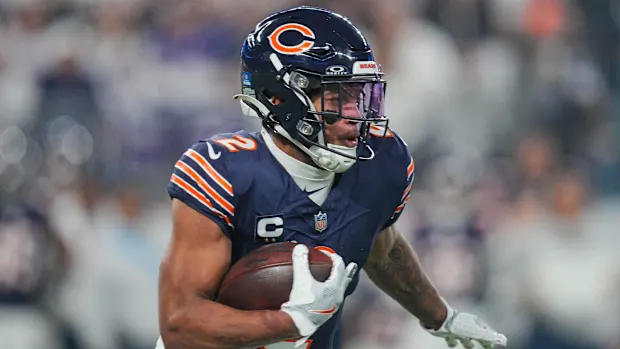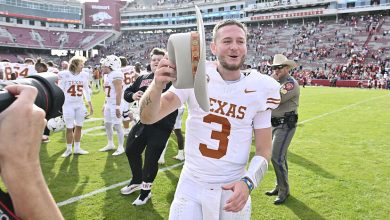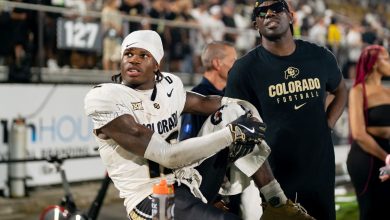Chicago Bears Star D.J. Moore Could Reportedly Lose WR1 Role as Younger Receivers Impress Coaches During 2025 NFL Training Camp

The Chicago Bears enter the 2025 NFL season with high expectations, a revamped offense, and a new franchise quarterback in Caleb Williams. But while much of the attention has centered on Williams’ development, a surprising storyline has quietly emerged from Halas Hall: veteran wide receiver D.J. Moore may be on the verge of losing his WR1 status.
Moore, acquired from the Carolina Panthers as part of the blockbuster 2023 trade that allowed the Panthers to draft Bryce Young, has been Chicago’s leading receiver since his arrival. His production and leadership helped stabilize the offense during turbulent quarterback play. However, with new offensive coordinator Tanner Engstrand and head coach Ben Johnson implementing a more dynamic, motion-heavy scheme, younger wideouts have begun to rise — and Moore’s top spot may no longer be guaranteed.
A Shift in the Bears’ Offensive Identity
Under Ben Johnson, known for crafting one of the NFL’s most creative offenses with the Detroit Lions, the Bears are implementing a more flexible, route-diverse system. Johnson’s approach puts a premium on versatility, timing, and separation — traits that play into the hands of some of Chicago’s younger receivers.
One name generating buzz is rookie Luther Burden III. The former Missouri star was drafted in the second round and has already impressed coaches with his elite route running, suddenness, and natural chemistry with Caleb Williams.
“Luther is ahead of schedule,” a Bears assistant coach told The Athletic. “He’s picking up the playbook faster than we expected, and his reps with the ones have increased every week.”
While Moore remains a respected veteran and productive option, the offensive system and the chemistry forming between Williams and Burden could lead to a significant shake-up in the receiver pecking order.
Moore’s Strengths — And Where He Could Be Losing Ground
Moore’s strengths are well documented. He’s a reliable target who plays through contact, excels in contested catches, and brings valuable experience to a young Bears locker room. In 2024, Moore posted 1,132 yards and 8 touchdowns, serving as the most consistent playmaker on a team still finding its identity.
However, there are signs that his grip on the WR1 role is loosening.
According to several training camp observers, Moore has struggled at times with separation against tighter man coverage — an issue that may be exacerbated in Johnson’s offense, which thrives on creating open throwing lanes through timing and space rather than contested catch situations.
“D.J. is still doing D.J. things,” noted a beat writer from the Chicago Tribune. “But when you see the way guys like Burden and even Tyler Scott are stretching the field and making quick reads on option routes, you get the sense the coaching staff is envisioning something new.”
Ben Johnson’s Comments Add Fuel
During a recent media availability, Johnson praised the wide receiver room’s depth but was non-committal when asked directly about Moore’s role.
“We’ve got a lot of competition at that spot, and I think that’s a good thing,” Johnson said. “D.J. brings consistency and toughness, but we’re going to keep evaluating every day.”
That vague assessment stood in contrast to his glowing remarks about the emerging chemistry between Williams and Burden.
“You see the trust already,” Johnson said. “Caleb knows where [Burden] is going to be, and he’s getting there on time. It’s exciting to watch.”
Locker Room Dynamics and Leadership
Beyond on-field performance, Moore has long been viewed as a locker room leader — someone younger receivers look up to for his preparation and professionalism. Several Bears players, including Williams, have praised Moore for his mentorship.
Still, in the NFL, leadership is often valued most when accompanied by elite performance.
“I think Moore is a huge asset, regardless of whether he’s the statistical WR1,” said a former Bears offensive coordinator. “But if a younger guy offers a better fit for the scheme or stronger chemistry with the quarterback, you have to make the tough call.”
What This Means for Caleb Williams
For rookie quarterback Caleb Williams, the evolution of the receiving hierarchy is critical. If Burden becomes the primary option, it may speed up Williams’ development by giving him a go-to target he feels comfortable with. But if Moore adapts and asserts himself in the new scheme, he could remain the veteran safety net a young quarterback often needs.
Williams has mostly remained quiet on the matter, focusing instead on mastering the playbook and adjusting to NFL speed.
“He’s not playing favorites,” one team source said. “But you can’t ignore the way his eyes light up when Burden is in motion.”
Implications for the Bears Offense
The idea of Moore losing his WR1 spot doesn’t necessarily mean he’s falling out of favor. Rather, it could reflect the broader evolution of the offense.
If Moore becomes more of a possession receiver or situational mismatch weapon, while Burden or Scott stretch the field vertically, Chicago’s offense may become more balanced and explosive.
This role diversification could also help keep defenses guessing — a staple of Johnson’s Lions offenses, where Amon-Ra St. Brown, Jameson Williams, and Sam LaPorta shared the spotlight in ever-changing alignments.
Trade Rumors?
Given Moore’s contract — he’s due $16.05 million in 2025 — some analysts have speculated whether the Bears could explore a trade if his role diminishes.
While there’s no concrete evidence of trade talks, ESPN’s Dan Graziano recently noted that “a surprise wide receiver trade could still happen before Week 1,” and listed Moore among “veterans to watch.”
Still, Moore’s reliability and leadership make him a valuable asset, and unless the Bears receive a compelling offer, a trade seems unlikely before the season begins.
D.J. Moore may no longer be the undisputed WR1 in Chicago, but that doesn’t mean he’s fading from relevance.
In fact, his ability to adapt, mentor, and deliver in clutch moments may prove even more valuable in a balanced, ascending offense led by a rookie quarterback.
For Moore, the key will be embracing this next phase — whether that’s as the primary target, a versatile No. 2, or a leader in the shadows.
Regardless of how the final depth chart shakes out, the Bears’ wide receiver competition is emblematic of a larger shift in Chicago — from rebuilding to reloading, and from hopeful to hungry.
Moore might not be the focal point anymore, but as the Bears chase playoff relevance in 2025, he’s still a vital part of the story.









